Photo analysis allows students to work with primary sources in a non-traditional way. This hands-on approach gives students the opportunity to establish, modify and validate their own perceptions and understanding of history and geography. This document contains methodological and technological guidelines for analyzing period photos and documents using ICT.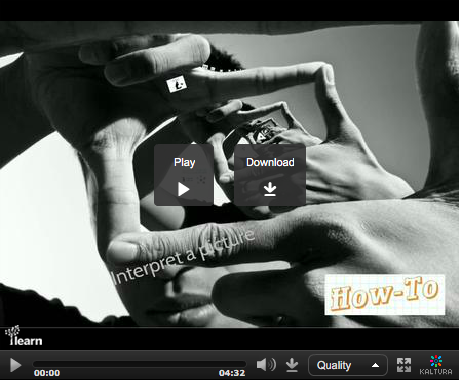
See also the student How-to entitled:
How to Interpret a Picture!
Explore
 Photo analysis enables students to develop their sense of observation, encourages them to formulate questions and make interpretations, and sharpens their critical faculties. Various factors influence how a photo is viewed and understood, including the reason why it was taken, the context in which it is presented, the information accompanying it and even the way it is physically framed.
Photo analysis enables students to develop their sense of observation, encourages them to formulate questions and make interpretations, and sharpens their critical faculties. Various factors influence how a photo is viewed and understood, including the reason why it was taken, the context in which it is presented, the information accompanying it and even the way it is physically framed.
Organize
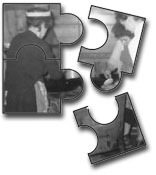
Photo analysis also produces a diagram of sorts, once students have identified and described the key elements of an image: who, what, when (context, time and space), where and why (place and purpose). This exercise enables students to grasp and reflect upon the complexities of a society and formulate hypotheses.
For example:
Students can formulate hypotheses in response to the photo below by answering a few simple questions.
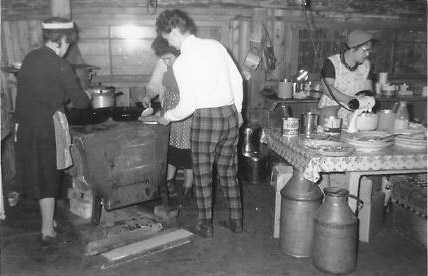
Source: Photo submitted by a student during a family heritage contest
| When was this photo taken? Where was this photo taken? If the photo is from your family’s photo album, can you interview (oral source) the people in the photo (the actors) or people who knew these people (witnesses)? |
Students can divide the elements they observe into the following categories:
| Politics: elections, demonstrations, government, justice, etc. Economy: work, energy, development, transformation, business activities, services, transportation, communications, associations, etc. Culture and society: fashion, food, architecture, manners and customs, recreational activities, public celebrationsCelebrations - A special activity or event Célébrations - Une activité ou un événement spécial ..., groups, significant life moments, external influences, etc. Geography: rural, urban, forest, water, soil, subsoil, seasons, etc. History: historical periods, currents, events, etc. |
Here is the same photo with annotations in text boxes created using a word processor. Step-by-step technological guides are available at the end of this document.

Note that the circles, text boxes and arrows were added to the photo using drawing tools that are available in most word processors (click here to see this photo analysis in Word). Vector graphics editors can also be used, Google Draw, Open Office, or Cartograf’s built-in image editor for attachments to points and shapes!
Gather more information about a problem
Students may conduct further research and validate their hypotheses using texts or other photos. They must first determine what their study topic is: sugar shacks, American influence, electricity, etc. This will help orient their research and facilitateThis means to help make an action or a process you do easier. Like when a... data collection. For the example above, students could consult the Hydro-Québec site, the CBC Archives site or other reference materials in order to develop a better understanding of the evolution of hydroelectricity in Québec, if this is the topic they have chosen.
Communicate
Creating a poster
Students can then share the results of their observations and research by creating a poster, for example.
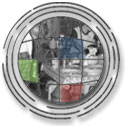
Students often do not employ visual elements to best effect when presenting the results of their intellectual endeavours. Instead, images are usually used as decorative elements. The poster they create should help solve or understand a problem, explain the evolution of a social reality and/or illustrate social change, as in the example below.
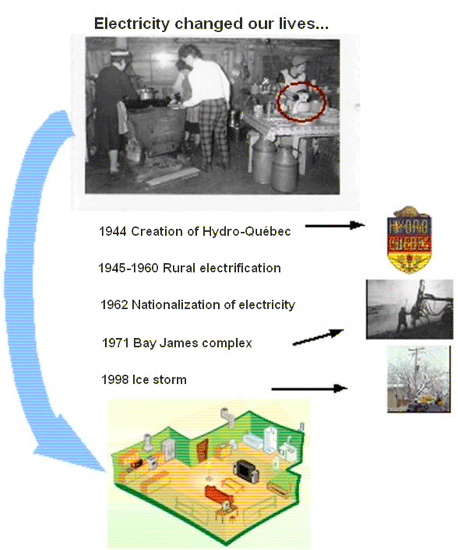
Historical narratives
Students can write a historical narrative by imagining dialogues between characters while using a history lexicon. They must understand the roles of the various people and main interest groups involved. They must also remember to include significant events and place them in the appropriate context and period.
To find out more about competency development using historical narratives, you can consult » Développer des compétences avec le récit historique » [in French only] on the website of the Service national du RÉCIT de l’univers social.
An article that describes strategies for using historical narratives in the history class can also be found here at Digital Historical Narratives.
Where to find photos?
Websites containing galleries of period photosConsult the bank of image galleries of the Service national du RÉCIT in the “Outils/Images” section to access period photos and documents.
Various sites with copyright-free media are also located here on the LEARN site.
Histografica: Search tool for finding old photographs from around the world
http://www.histografica.com/
And consider also the images here on Societies and Territories…. of course!
A few examples:
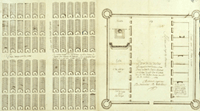 | Evangelization of the Indigenous Peoples by the Récolets and the Sulpicians. Here is the plan of a Sulpician mission for the conversion. The number of long houses is a good indication of the size of this mission Image source: New France: New Horizons |
 | Map of New France illustrating various aspects of Indigenous ways of life. Image source: New France: New Horizons |
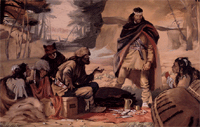 | The fur tradeTrade is when we buy, sell, or just exchange goods (things, foods, etc.) or services (helping...: influence of other cultures, tradeTrade is when we buy, sell, or just exchange goods (things, foods, etc.) or services (helping..., way of life, etc. Image source: McCord Museum |
 | Image characteristic of the Canadian West: steam locomotive and freight train at elevator. Image source: Canada Science and Technology Museum |
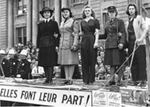 | Women and the war effort. Image source: McCord Museum |
Looking for other ways to incorporate photos and documents? Check out LEARN’s Be a History Detective tools!

